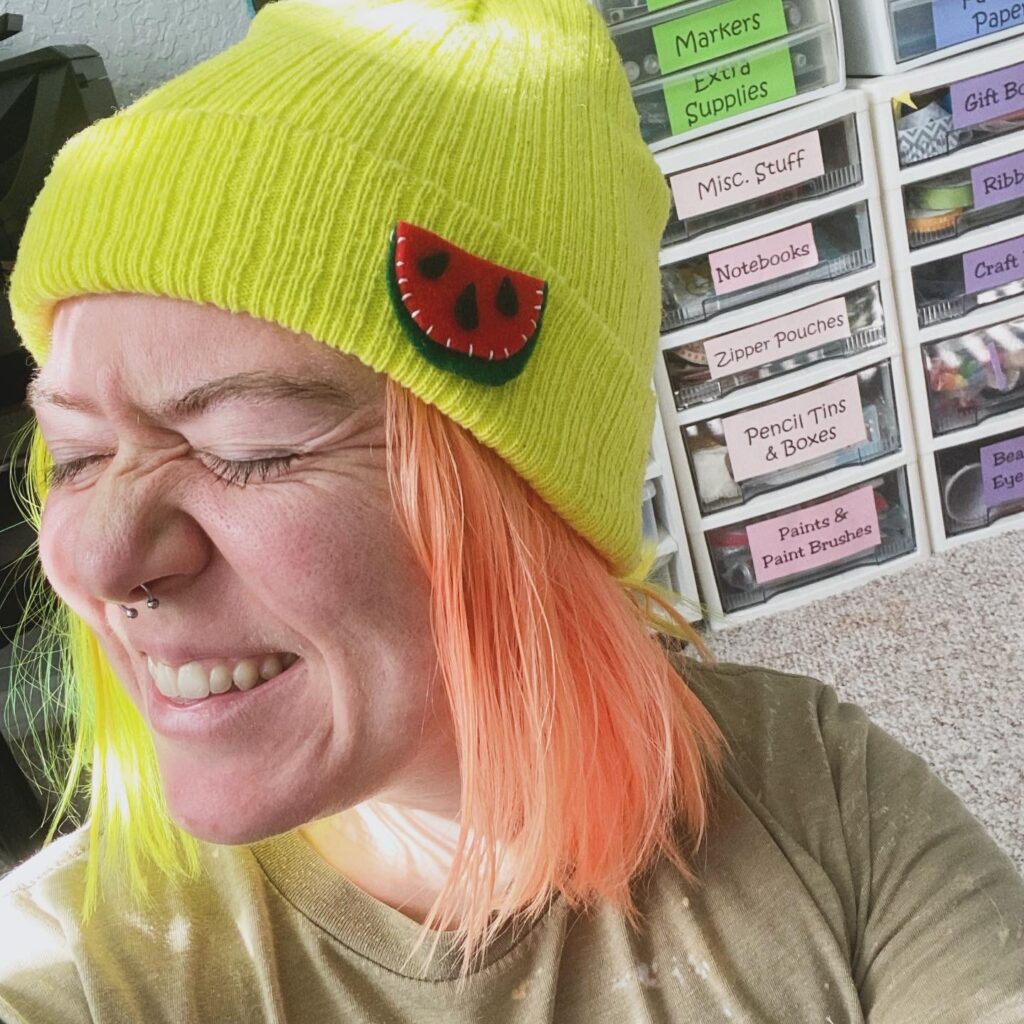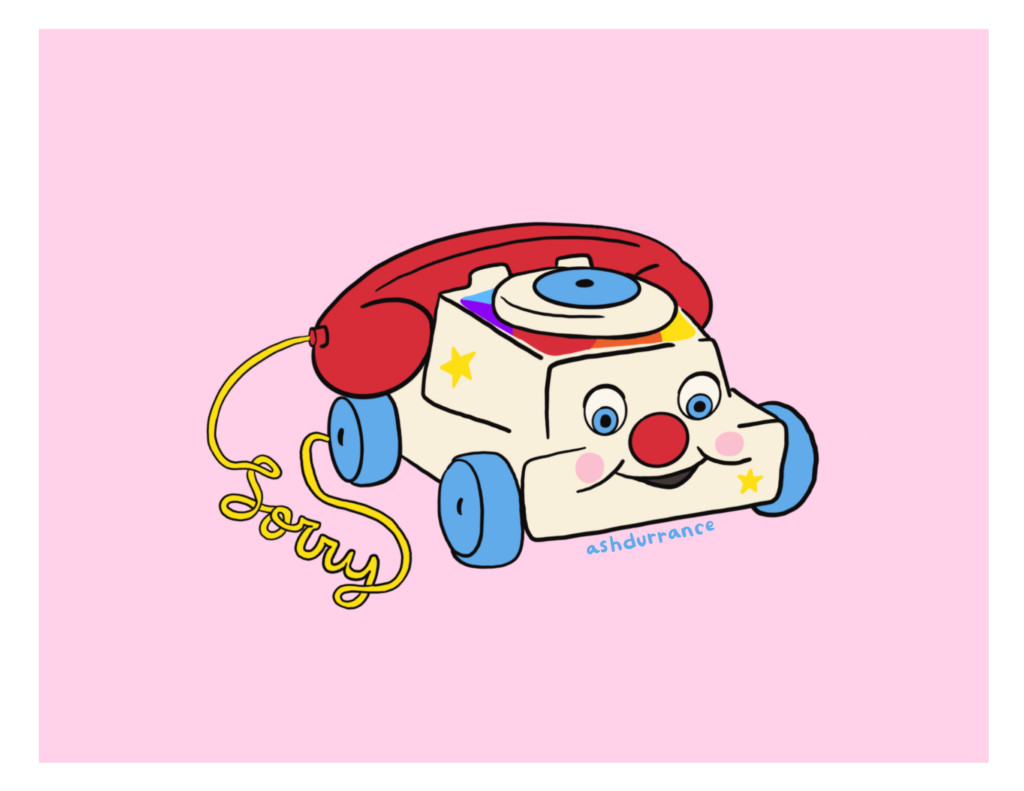Intro and interview by Amanda Flinn
Ash Durrance is an artist who comes from a long line of creative women. Raised in Orlando, Fla., Durrance’s moth- er worked as a costume manager at Disney, crafting her own party invitations and painting mermaids in her spare time. Durrance’s grandmother created miniature bears — Teddy Roosevelt was her most popular design — and eventually became a photographer. Durrance’s younger sister is a fashion designer.
While Durrance has been creating art her whole life, it wasn’t until her move to Cape Girardeau in 2022 that she began to pursue art with passion and purpose, helped in part by finding an art community that welcomed and encouraged her.
Here, Durrance discusses the type of art she creates, along with the inspiration behind it. And while she knows her whimsical, sometimes angry, style isn’t for everyone, the process of creating it has been healing for her.
Amanda Flinn: What can you tell us about the kind of art you create?
Ash Durrance: I create digital illustrations and comics using Procreate on a hand-me-down iPad, but I also draw comics and zines by hand. I typically fill my sketchbook with still lifes of my apartment using ink and sometimes Copic markers. But I’m really into mixed media work, too. Like, I just made a big collage piece with all the flyers and posters I’ve made for protests over the past five years. And I like using objects I’ve amassed and collected, from old pieces of art to things like prescription bottles and old glucose test strips — I’m a type-one diabetic. I’m trying to reduce waste and all that.
What inspires you as an artist?
My art aims to say things that I feel, or have felt, or that haven’t been said loudly enough. I want my art to scream “I am woman” or “Yes, I bleed, and it’s OK to talk about it.” Or even, “I have a vagina, and you should know what one looks like.” I’m passionate about saying things I felt I wasn’t allowed to say for most of my life, things I wasn’t told about or things it seemed no one else was willing to talk about.
Have you always been passionate about political change and human rights? Probably around middle school is when it began for me. I remember being 11 and asking my mom if I could go vegetarian. I ran for class president in 7th grade, got super into eco things, hugging trees and recycling, for instance. It was a mix of upset — like knowing animals suffered in the meat industry — and wanting to take action. I began educating myself in a way that shaped my individual per- sonhood and how I existed in the world, which stayed with me.
Before moving to Cape, I was living in Carbondale [Illinois], which is such a cool town full of kooky artists, and there were political protests. Coming here, it was tough finding people I could share my passions with. It’s frustrating, because so many things are happening politically that people aren’t aware of. That’s birthed this art movement, also. I started designing stickers [about the latest Israel-Hamas War] and printing them at home. One hundred percent of the money I make goes to purchase eSIMs for people in Gaza who don’t have reliable cell service. It’s just a way to buy data with your phone, so they can communicate with their families, but it’s something I can do.
Earlier, you mentioned the word “zine.” What is that?
“Zine” is originally after “fan magazine” and essentially came about in the ‘60s when punk folks started making little books and posters reviewing bands they like and passing them around. Literally anyone can do it. There’s been a rise in self-publishing, and I’d like to see a punk revival of that. I often use zines to express an idea or find a solution to something that’s bugging me. In the process of making one, I am often trying to understand a complex issue and, like, transform it from a nebulous idea to a 3D object, which I can then copy, distribute and use to inform, entertain, protest, be silly, etc.
Have you had formal training as an artist, or is it something you’ve learned along the way?
I’ve never had formal art training in anything, so whatever appeals to me, I do that. There are a lot of artists on Instagram that post the same stuff, and it all looks similar. I get bored of that. I’m not interested in doing the same sort of medium.
But I do have an undergraduate degree in English and anthropology with a minor in Latin. In graduate school, I earned a degree in English Literature and Creative Writing. Later, I received a MFA in Poetry. Whenever I was exhausted from grading papers or stressed from writing my thesis, I would turn to art. It’s always been fun for me. I don’t know if I’ll ever make a living off my art, but if I could combine my degrees with art and writing political poetry, I’d love that.
Who are you hoping to reach with your art?
I’m trying to reach young women in their teens and twenties, but even my age and older. I’m a sexual assault survivor, so that’s part of my audience. I have an online shop and Instagram page, plus I pass out stickers and flyers across campus. Through that, I’ve met several students from the Islamic Center who let me know they appreciate what I’m doing. But, I’ve also had a business say [my work] is too vulgar for their customers, and I have to accept that. It’s not for everyone. I’m trying to do something big through something small. It’s a tight corner I’ve put myself in.
How have you been able to get involved with the community?
I got involved with the Arts Council soon after I moved to Cape. They needed a board member, and that pulled me out and into the community. I had my first-ever gallery piece last summer. This September, I’m going to be in a micro gallery there. Probably about menstruation. My online following is small, but I keep making more connections through the Arts Council and SEMO campus. It’s reassuring.
SUBSCRIBE TO THE FLOURISH PATREON COMMUNITY AT THE $10 PER MONTH LEVEL TO RECEIVE A DIGITAL WALLPAPER CREATED BY ASH DURRANCE.



